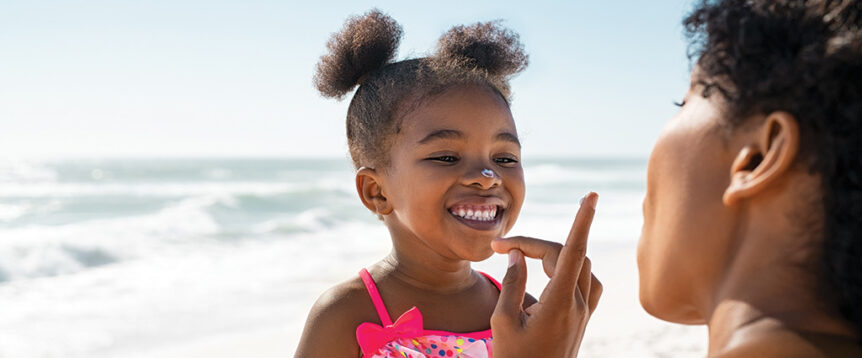Different ages, different stages, different risks
Children are more vulnerable to exposure to environmental toxins than adults for many reasons. Firstly, toxins can be passed onto fetuses and babies during pregnancy and breastfeeding, putting children at increased risk of childhood illness and development disorders.
What’s an environmental toxin?
Environmental toxins are chemicals or other factors present in our environment that may cause adverse health effects in the people exposed to them.
Since children’s bodies are smaller, any toxins they ingest effectively come in a larger dose. Given their proximity to the ground, children are physically closer to toxins lurking in dust and soil.
Kids consume more water and milk, which are potential vectors of toxins, for their size than grown-ups do. And as any parent or caregiver is aware, kids are more likely to engage with their environment using their mouths and hands, giving toxins a direct entry point.
Finally, according to Dr. Laura Nicholas, ND, limits on safe toxin exposure are often based on studies done on adult males, meaning that we don’t have a solid understanding of safe toxin loads for little ones.
What’s the impact?
These factors put children at heightened risk of being exposed to hazards that can alter their cognitive function and development. In children, exposure to toxins has been linked to developmental delays, hormonal disturbances, respiratory and skin issues, obesity, and intellectual disabilities.
Research on the impact of environmental toxins on children is usually done retroactively given ethical considerations, making it hard to draw conclusions. “We won’t be able to get better data,” says Nicholas. “What we need is more data over time on these issues.”
Toxins to watch out for
Common environmental toxins include naturally occurring compounds such as lead, mercury, benzene, and formaldehyde, as well as synthetic substances such as bisphenol A (BPA) and bisphenol S (BPS), parabens, pesticides, phthalates, polychlorinated biphenyls (PCBs), and toluene.
Many of these toxins can be found in household sources: food residue, food packaging, household dust, foam-filled furniture, carpeting, personal hygiene products, and tap water. Kids may encounter toxins at home, school, daycare, and even outside when playing in sand or dirt.
Keep your little one safe
It may feel overwhelming, but there are straightforward steps you can take to cut down on children’s toxin exposure. Nicholas recommends starting with the air they breathe.
What they breathe
Consider getting a high efficiency particulate air (HEPA) filter for your home, flick on the vent fan when cooking, and avoid exposing children to secondhand smoke. Get children out in nature as much as possible and bring nature to you with air-purifying house plants.
What they consume
Then, take a look at things that go in your child’s body, like food, water, and medications. Choose organic foods as much as possible, and wash produce well. Choose glass, stainless steel, or ceramic containers and tableware instead of plastic containers, and if you’re worried about the quality of your tap water, consider investing in a filter.
Keep an eye on young children at the park and gently discourage any erroneous snacking on sand or dirt. Talk to a pediatrician about the possibility of cutting down on non-essential medications that may put strain on a child’s liver and slow down their natural detoxification processes.
What you clean with
Finally, think about what goes on your child’s body: lotions, shampoos, soaps, and household cleaning products. Where possible, shift to natural, nontoxic, and fragrance-free options, and dust and vacuum your home frequently.
Although it’s not always possible to completely avoid antibacterial soaps and sanitizers, children should be encouraged to wash their hands with natural soap and water as much as they can.
Toxic toys
New research has found that plastic toys can contain more than 100 harmful chemicals. To choose toys that are better for people and the planet, look for those made of natural materials, like wood or organic cotton.
Sun safety, safely
While sunscreen is meant to protect skin from sun damage, you may have heard that some can do more harm than good—but not all sunscreens are created equal.
For a gentler option you can feel good about slathering on, opt for mineral-based sunscreens with titanium dioxide or zinc oxide. These provide ample protection without unwanted chemicals being absorbed into the skin.
Try Babyganics Mineral Based Sunscreen Lotion for broad-spectrum, SPF 50 protection in a non-allergenic, tear-free formula.
For children older than six months, apply a generous amount of water-resistant, broad-spectrum (UVA and UVB-blocking) sunscreen, of at least 30 SPF, 30 minutes before heading outside. Be sure to reapply every two hours or after swimming and sweating. According to the American Academy of Dermatology Association (AAD), parents should minimize sunscreen use on children under six months.
In addition, be sure to keep little ones protected under a stroller hood, umbrella, or other form of shade. Dress babies in lightweight, long-sleeved clothing as well as a wide-brimmed hat and sunglasses with UV protection (if they’ll allow it!).

